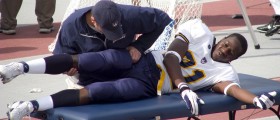
Sprained Foot Characteristics
The inside of our feet consists of more than 20 tiny bones, that are connected to each other. Thus, the fact that there are many different foot injuries is not so strange since this part of our body is quite vulnerable. The main type of foot injury is a foot sprain, which can occur, when the ligaments in our foot get damaged due to excessive stretching or overstraining. Ligaments are tissues that connect our bones to one another. Depending on the severeness of a foot sprain, there are three levels of this injury. The first one is light and contains invisible, nevertheless present, tears on the surface of our ligaments. The second one is a more moderate injury, where there is a visible tear in these body parts while the final, third type of this injury involves a completely torn ligament inside our foot.
Once You Sprain Your Foot
There are two places where a foot sprain may occur. The first one could be in the the midfoot and the area around it, while the second affects the ball of our foot and often transfers onto our big toe. The first sign is, tenderness and pain, as well as swelling in the affected area. Also, with swelling comes bruising and general discoloration due to the injury. Of course, more serious injuries will deprive one of foot mobility and will produce greater amounts of pain and discomfort. Luckily, in cases of foot injury of this type, joints are rarely affected, even though your big toe might hurt if your sprain is located in the ball of your foot.
Diagnosis and Treatment
Once you pay your doctor a visit, he will look for the known symptoms of foot sprain. Basically, these will be the ones mentioned throughout the previous lines. However, if the damage appears more serious, the doctor will recommend an X-ray in order to establish a proper diagnosis. Once all this is done, proper therapy will be prescribed.
The treatment often involves resting and applying ice, to take care of the swelling and inflammation. Also, you should keep the foot compressed and elevated during your recovery period, in order to stop the bruising. More serious cases may involve wearing a cast, or some other type of immobilization until the damage is repaired.

















Your thoughts on this
Loading...